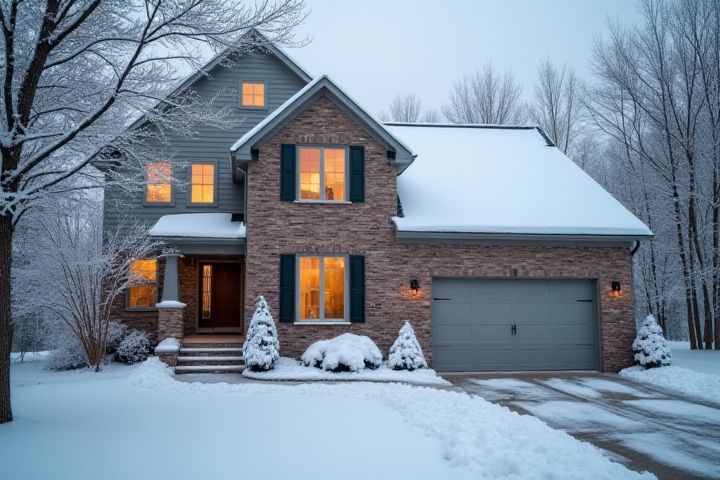
To winterize your house efficiently, start by sealing any gaps around windows and doors with weatherstripping or caulk to prevent drafts. Insulate pipes in unheated areas to minimize the risk of freezing, and consider adding insulation to your attic to improve heat retention. Next, disconnect and drain exterior hoses to prevent burst pipes and ensure your irrigation system is properly winterized. Check your heating system, change filters, and schedule a professional inspection to guarantee optimal performance during colder months. Finally, prepare your home's exterior by cleaning gutters to prevent ice dams and clearing away debris that could damage your roofing.
How To Winterize A House Efficiently
Seal windows and doors
Seal windows and doors effectively to prevent cold drafts and minimize heat loss during winter. Use weather stripping or caulk to fill gaps, ensuring a snug fit around frames, which can reduce heating costs by up to 20%. Inspect your windows and doors for any cracks or deterioration, making necessary repairs to optimize insulation. Utilizing clear plastic film for added insulation can also enhance energy efficiency while allowing natural light to filter into your home.
Insulate pipes
Insulating pipes is crucial for preventing freezing during winter months, particularly in unheated areas like basements, attics, or garages. Use foam pipe insulation or fiberglass sleeves, which are easy to install and can reduce heat loss by up to 80%. Pay special attention to vulnerable spots, such as exterior walls, where temperatures can plummet; insulating these areas can save you from costly repairs due to burst pipes. Check for drafts around windows and doors to ensure your insulated pipes are protected from cold air infiltration, enhancing your home's overall energy efficiency.
Clean gutters
Cleaning gutters is essential for efficient winterization, as clogged gutters can lead to ice dams and water damage. Use a sturdy ladder to safely access your gutters, removing leaves, twigs, and debris; aim for a clear path for water flow. Installing gutter guards can help reduce future debris accumulation, enhancing your home's winter readiness. Regular maintenance, at least twice a year, ensures your gutters function properly, preventing costly repairs when spring arrives.
Service heating system
Service your heating system by scheduling a professional inspection at least once a year, ideally before the heating season begins. Ensure that you replace or clean air filters every 1 to 3 months to maintain airflow and efficiency, as clogged filters can reduce heating effectiveness by more than 15%. Check for leaks in ductwork, which can account for up to 30% loss in energy efficiency, and seal any gaps with appropriate materials. Consider installing a programmable thermostat to optimize your heating schedule, potentially saving you 10-30% on heating costs throughout the winter.
Reverse ceiling fans
Reverse ceiling fans can significantly enhance your winterization efforts by improving air circulation in your home. By setting your ceiling fan to spin clockwise at a low speed, warm air that rises to the ceiling can be pushed back down into the living space, efficiently distributing heat and reducing energy costs. For optimal effectiveness, adjust the fan speed to match the warmth of your room, ensuring a comfortable atmosphere while relying less on your heating system. This simple adjustment can help maintain a steady temperature throughout your home during the colder months.
Wrap water heater
To winterize your house efficiently, start by wrapping the water heater with an insulating blanket, which can reduce heat loss by around 25% to 45%. Choose a water heater blanket with an R-value of at least 8 for optimal insulation. Ensure the blanket fits snugly around your water heater, covering all accessible sides while avoiding contact with the power source or exhaust vents. This simple step can save you up to 10% on your energy bills during the colder months, enhancing overall energy efficiency.
Install weather stripping
Installing weather stripping around doors and windows can significantly reduce heat loss, potentially saving you up to 20% on energy bills during winter. Choose materials like foam tape, V-seal, or door sweeps based on the area you are sealing; each provides various levels of insulation efficiency. Ensure a tight fit by measuring door frames and window edges accurately, cutting the stripping to the correct lengths for seamless application. This simple process not only enhances comfort in your home but also helps maintain consistent indoor temperatures throughout the frigid months.
Check roof for leaks
Inspecting your roof for leaks is crucial for effective winterization. Start by examining the roof's exterior for any visible cracks or missing shingles, as these can lead to water intrusion during snowmelt. Inside your attic, look for any signs of water stains or dampness on the ceiling and walls, which may indicate existing leaks. Addressing these issues promptly can save you from costly water damage repairs, ensuring your home remains safe and comfortable throughout the winter months.
Trim tree branches
Trimming tree branches is essential for winterizing your house, as it helps prevent potential damage from heavy snow or ice accumulation. Aim to remove any branches within 10 feet of your roofline, as well as dead or overhanging branches that might break under weight. Regularly pruning overgrown trees not only enhances your home's appearance but also reduces the risk of pests and diseases. You may want to schedule tree trimming in late fall, ideally when the trees are dormant, ensuring a safe and efficient winterizing process.
Close foundation vents
To winterize your house effectively, begin by closing foundation vents to prevent cold drafts and moisture from entering your crawlspace. This action helps maintain a stable temperature, reducing heating costs and preventing frost damage to plumbing. Ensure the vents are securely sealed, possibly using foam insulation or covers designed for this purpose. Additionally, take the opportunity to inspect the surrounding drainage systems to channel melting snow and rain away from your foundation, protecting it from potential winter water damage.
